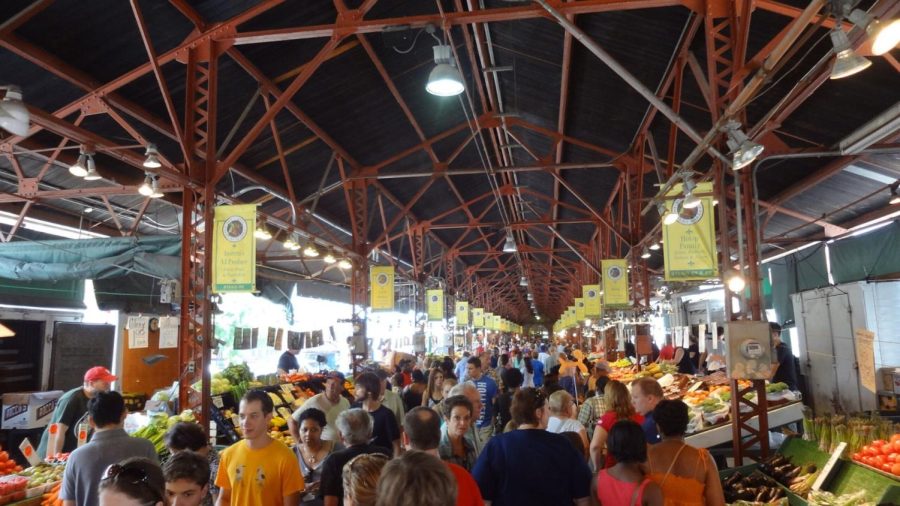Why we love farmers’ markets and where to find them
All across the country, these places highlight farmers and bakers who sell their goods directly to consumers; best of all, for the kosher cook and eater, the selections are nearly unlimited.
Soulard Farmers Market in St. Louis on a busy August day in 2011. Credit: Paul Sableman via Wikimedia Commons.
Published July 28, 2022
There is just something about a farmers’ market. Living in south St. Louis, I am fortunate enough to live very close to Tower Grove Park, where every Saturday, my wife and enjoy taking our dogs to the Tower Grove Farmers Market, where we browse, and check out all the vendors have to offer.
The offerings of several local farms can be found, including meat and eggs, local wines, cheeses, and a local, small-scale bakery. There are also food trucks, beer, and a place to get your knives sharpened. There is something for everyone.
St. Louis is also home to one of the oldest operating farmers’ markets in the country, down in Soulard. So, when I caught a piece by Jewish writer Ethel G. Hofman, who included Soulard in her latest work, I thought St. Louis might be interested in her perspective.
Here it is. And at the end of the story, please check out a list of all the farmers’ markets in our area.
Making a stand for seasonal farmers’ markets
At the top of my summer list of small pleasures is discovering farmers’ markets. Popping up at roadsides all across the country—from California to New York—baskets of produce brim with color and the clean flavors of being freshly harvested. You’ll also find seasonal produce at indoor markets where local farmers bring homegrown fruits, vegetables, jams, chutneys and fresh-baked goods to sell at booths. To jaded taste buds, there’s nothing quite like it. Best of all, for the kosher cook and eater, the selections are nearly unlimited, though check jars and packages for hechshers before buying.
Farmers’ markets have flourished throughout history. Soulard Farmers Market St. Louis and the Pike Place Market in Seattle and are two of the oldest and largest operating farmers markets in the United States.

Then there are individual family farms that dot Dutch country all the way from Lancaster, Pa., to Ohio, with roadside stands along the way. All across the country, these places highlight farmers and bakers who sell their goods directly to consumers. It’s the easiest way to purchase locally grown fresh produce while helping small businesses increase their profits, as opposed to larger grocery chains. At the same time, it creates social activity—a relaxing place to shop, and have a cup of coffee or tea and a slice of fruit pie with friends. There’s little waste, if any, and you know directly where the produce comes from, usually less than a few hours away. Herbs such as dill and parsley are bright and crisp, never doused with supermarket water or sprinklers to be refreshed. You can also find unusual items on display. When I came across a new varietal of radishes or beets, the grower was on hand to answer my questions with tips on how to cook and serve.
Fresh fruits and vegetables are all nutritious, organically grown or not. Still, organic produce is becoming more and more popular for those who can afford it. On average, organic foods often costs 50% more than those conventionally produced. The U.S Department of Agriculture defines organic as crops free from most synthetic pesticides, herbicides or fertilizer for three years before harvesting. There also needs to be a significant buffer zone to decrease contamination from adjacent farmlands. Any product labeled organic must be USDA-certified, and the producer may also use an official USDA organic seal. That, of course, accounts for the higher production and labor costs, which get passed on to the consumer.
Where farmers’ markets are seasonal, food co-ops offer year-round produce, dairy items and basic ingredients. These are food-distribution outlets organized by members who pay a monthly fee, although anyone can shop there. Members get discounts, and in return, may have to work at the co-op for up to a designated number of hours a year and get first dibs on specials. The focus is on local, organic or other more sustainably sourced food items. Farm Share, another way to get seasonal produce, is available for about 26 weeks. A box of produce, whatever is readily available and plentiful, is delivered weekly or twice a month from farm to home. Costs vary on location but range from $365 to $400, paid upfront.
- Tower Grove Farmers’ Market
- U. City Farmers’ Market
- S.O.L. Food Farmers Market (Formerly Schlafly Farmers’ Market)
- Ferguson Farmers’ Market
- Kirkwood Farmers’ Market
- Lake St. Louis Farmers’ & Artists’ Market
- Wildwood Farmers’ Market
- Land of Goshen Community Market
- Farmers’ Market at The Boulevard
- Vine Street Market at O’Fallon Station
- Arnold Farmers Market
The recipes below bring on the best of the season.
Israeli Blessing Salad was an off-the-cuff recipe created when I joined chefs to cook “To the Army With Love.” The challenge was to use common ingredients found in an Israeli Army mess hall. Fresh herbs, including fragrant mint, which grew wild on the hillside outside the barracks, inspired this herb salad. Kissel, popular with Eastern European Jews, is a silky pudding using summer fruits and berries, such as plums and strawberries. Lamb Tagine With Seven Vegetables is from my cookbook, Everyday Cooking for the Jewish Home. Honeydew Refresher, a three-ingredient starter using overripe honeydew, was whipped up for unexpected supper guests. Substitute cantaloupe, seeded watermelon or any soft fruits such as peaches. And a resurfaced recipe for Green Tomato Pie uses end-of-season green tomatoes. The resemblance to apple pie is uncanny!
Of course, there’s no need to cook a perfect, fuzzy-skinned peach or a smooth, freshly picked nectarine. Eat in hand, the juices dribbling down your chin as you savor the scents of summer.
Honeydew Refresher (Dairy)
Serves 6
Cook’s Tips:
*Made in minutes or up to a day ahead, cover and refrigerate.
*Use vanilla yogurt and no need for other sweetening.
Ingredients:
4 cups honeydew melon, cut into coarse 1-inch chunks
½ cup orange juice
½ cup plain yogurt
honey to taste
Directions:
Place all ingredients in a blender jar or food processor. Blend until smooth. Serve right from blender to chilled glass.
Lamb Tagine With Seven Vegetables (Meat)
Serves 6
Cook’s Tips:
*Substitute 4 cups fresh spinach for Swiss chard.
*Swiss chard is a member of the beet family. The greens can be prepared like spinach, the stalks like asparagus.
Ingredients:
2½ pounds cut-up lamb shoulder
2 carrots, sliced 1-inch thick
2 cups pumpkin or squash, cut into 2-inch chunks
2 small white turnips, peeled and quartered
2 small onions, peeled and sliced, ¼-inch thick
2 medium-sized zucchinis, cut into 1-inch chunks
1 bunch Swiss chard, trimmed and sliced ½-inch thick
1 leek, washed trimmed and sliced ½-inch thick
¼ cup olive oil
1 tablespoon cumin
½ teaspoon each, salt and pepper
Topping: ¼ cup sugar and 1 tablespoon cinnamon
Directions:
Preheat oven to 350 degrees.
In a large Dutch oven, place the lamb, carrots, pumpkin, turnips, onions, zucchini, Swiss chard and leek. Stir in the oil, cumin, salt and pepper.
Pour in just enough cold water to cover. Bring to a boil. Cover and bake in a preheated oven for 1 hour and 15 minutes.
Remove lid and bake 15 minutes longer.
Raise oven heat to 425 degrees. Sprinkle sugar and cinnamon over the top of the stew.
Continue baking, uncovered, until cinnamon sugar is slightly caramelized, about 20 minutes. Serve with couscous or rice.
Israeli Blessing Salad (Pareve)
Serves 6
Cook’s Tips:
*Any combination of green herbs will do. To tame flavors, toss in some finely shredded lettuce.
*Snip off the tough ends of bunches of herbs.
*A salad spinner is an essential kitchen utensil.
*A “bunch” is 3 to 4 cups, loosely packed.
Ingredients:
⅓ cup bulgur wheat
Boiling water
1 bunch parsley, washed and spin-dried
1 bunch basil, washed and spin-dried
½ bunch mint, washed and spin-dried
½ cucumber, unpeeled and diced
¾ cup dried cranberries or raisins
⅓ cup pumpkin seeds
3 tablespoons freshly squeezed lemon juice
¼ cup extra-virgin olive oil
Salt and freshly ground pepper to taste
Directions:
Place the bulgur wheat in a small bowl. Cover with boiling water and let stand for 10 to 15 minutes to soften. Drain well. Set aside.
Cut the parsley, basil and mint into chunks. Place in a food processor and chop coarsely.
Transfer to a large bowl. Add the bulgur and remaining ingredients. Toss to mix.
Serve at room temperature.
Farmer’s Potato Salad (Dairy)
Serves 6
Cook’s Tips:
*Use small red or fingerling potatoes. No need to peel them.
*Substitute mayonnaise for yogurt to make recipe pareve.
*Chop bell pepper coarsely in a food processor. If there is any extra, place in a small container and freeze.
Ingredients:
2 pounds (15 to 16) mini-red potatoes, scrubbed
2 tablespoons rice vinegar
¼ cup extra-virgin olive oil
2 teaspoons plain yogurt
2-3 tablespoons orange bell pepper, chopped
Salt and freshly ground pepper to taste
Directions:
Place potatoes in a medium pot, cover with water and bring to a boil. Reduce heat to a slow boil.
Cook for 15 minutes or until a knife inserted slides out easily. Drain. Set aside to cool.
In a serving bowl, whisk together the vinegar, olive oil and yogurt.
Cut the potatoes into bite-size pieces. Add to the bowl and toss. Fold in the bell pepper.
Season to taste with salt and pepper.
Garnish with parsley (optional). Serve chilled.
Raspberry-Peach Kissel (Pareve)
Serves 4-6
Cook’s Tips:
*Serve in those rarely used demitasse cups or wine glasses.
*1 medium lemon yields approximately 3 tablespoons lemon juice.
*Garnish with shaved pareve chocolate.
Ingredients:
4 ripe peaches, thinly sliced
1 cup raspberries
⅓ cup sugar
3 tablespoons freshly squeezed lemon juice
2½ cups water, divided
3 tablespoons cornstarch
Directions:
In a medium saucepan, combine peaches, raspberries, sugar, lemon juice and 2 cups of water.
Bring to a boil over medium heat. Cover and cook until the fruit is soft, about 10 minutes.
In a small bowl, blend cornstarch and ½ cup of water to a smooth paste.
Add to the fruit, stirring constantly until thickened and clear, about 4 to 5 minutes. Cool slightly.
Transfer to a blender jar or food processor. Purée until smooth.
Pour into dessert cups or glasses. Serve chilled.
Green Tomato Pie (Pareve)
Serves 8
Cook’s Tips:
*Short on time? No need to peel apples; just core and slice.
*Any type of apple may be used.
Ingredients:
10-inch prepared pastry crust
4 cups green tomatoes, sliced ½-inch thick
2 cups peeled and cored apples, sliced ¼-inch thick wedges
1 teaspoon grated lemon peel
¾ cup sugar
¼ teaspoon ground ginger
1 teaspoon cinnamon
¼ cup all-purpose flour
1 tablespoon cold water
Directions:
Preheat oven to 425 degrees.
Line a 9-inch pie dish with the pastry crust. Set aside.
In a large bowl, combine the tomatoes, apples, lemon peel and sugar. Sprinkle the ginger, cinnamon and flour over top. Toss to mix well.
Transfer to the pie dish. Sprinkle with water.
Bake in preheated oven for 15 minutes. Reduce to 375 degrees.
Continue baking for 40 to 50 minutes or until juices are bubbly. If the crust is browning too quickly, cover edges with foil.















